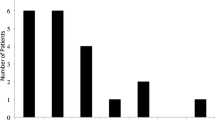Abstract
Earlier studies have shown the effect of laser treatment on epistaxis in patients with hereditary hemorrhagic telangiectasia (HHT). At the present time, only very few prospective trials have been performed, and many studies are based on patients’ subjective assessment of the severity of epistaxis. This prospective study measures the objective effect of laser treatment in HHT patients with mild to moderate epistaxis. We introduce an objective measure to assess the severity of epistaxis: the bleeding time (BT). Before and after treatment, the quality of life, as measured by the patient, was assessed and compared to normative data. In 30 patients, we measured the BT before laser treatment 1.5 and 6.5 months after treatment. The Short form 36 (SF-36), a validated health questionnaire, was completed before and 6.5 months after treatment. Compared to preoperative value, BT was significantly reduced 1.5 and 6.5 months after laser treatment (p < 0.05) in both cases. No significant difference in quality of life, before and after treatment, was found. The quality of life of the HHT patients was reduced in five out of eight dimensions when compared with the Danish background population. Laser treatment reduces epistaxis in HHT patients with mild to moderate epistaxis for at least 6 months; this group of patients have reduced quality of life compared to the background population.



Similar content being viewed by others
References
Shovlin CL, Guttmacher AE, Buscarini E, Faughnan ME, Hyland RH, Westermann CJ et al (2000) Diagnostic criteria for hereditary hemorrhagic telangiectasia (Rendu-Osler-Weber syndrome). Am J Med Genet 91(1):66–67
Kjeldsen AD, Vase P, Green A (2000) Hereditary hemorrhagic telangiectasia. A population-based study on prevalence and mortality among Danish HHT patients. Ugeskr Laeger 162(25):3597–3601
Lennox PA, Harries M, Lund VJ, Howard DJ (1997) A retrospective study of the role of the argon laser in the management of epistaxis secondary to hereditary haemorrhagic telangiectasia. J Laryngol Otol 111(1):34–37
Kluger PB, Shapshay SM, Hybels RL, Bohigian RK (1987) Neodymium-YAG laser intranasal photocoagulation in hereditary hemorrhagic telangiectasia: an update report. Laryngoscope 97(12):1397–1401
Illum P, Bjerring P (1988) Hereditary hemorrhagic telangiectasia treated by laser surgery. Rhinology 26(1):19–24
Lennox PA, Hitchings AE, Lund VJ, Howard DJ (2005) The SF-36 health status questionnaire in assessing patients with epistaxis secondary to hereditary hemorrhagic telangiectasia. Am J Rhinol 19(1):71–74
Al-Deen S, Bachmann-Harildstad G (2008) A grading scale for epistaxis in hereditary haemorrhagic teleangectasia. Rhinology 46(4):281–284
Pagella F, Semino L, Olivieri C, Corno S, Dore R, Draghi F et al (2006) Treatment of epistaxis in hereditary hemorrhagic telangiectasia patients by argon plasma coagulation with local anesthesia. Am J Rhinol 20(4):421–425
Kuhnel TS, Wagner BH, Schurr CP, Strutz J (2005) Clinical strategy in hereditary hemorrhagic telangiectasia. Am J Rhinol 19(5):508–513
Karapantzos I, Tsimpiris N, Goulis DG, Van HH, Van CP, Danielides V (2005) Management of epistaxis in hereditary hemorrhagic telangiectasia by Nd:YAG laser and quality of life assessment using the HR-QoL questionnaire. Eur Arch Otorhinolaryngol 262(10):830–833
Geisthoff UW, Heckmann K, D’Amelio R, Grunewald S, Knobber D, Falkai P et al (2007) Health-related quality of life in hereditary hemorrhagic telangiectasia. Otolaryngol Head Neck Surg 136(5):726–733
Bjoerner JB, Damsgaard MT, Watt T et al (1997) Danish manual to SF-36. LIF, Copenhagen (In danish)
Geisthoff UW, Fiorella ML, Fiorella R (2006) Treatment of recurrent epistaxis in HHT. Curr Pharm Des 12(10):1237–1242
Hoag JB, Terry P, Mitchell S, Reh D, Merlo CA (2010) An epistaxis severity score for hereditary hemorrhagic telangiectasia. Laryngoscope 120(4):838–843
Conflict of interest
None.
Author information
Authors and Affiliations
Corresponding author
Rights and permissions
About this article
Cite this article
Jørgensen, G., Lange, B., Wanscher, J.H. et al. Efficiency of laser treatment in patients with hereditary hemorrhagic telangiectasia. Eur Arch Otorhinolaryngol 268, 1765–1770 (2011). https://doi.org/10.1007/s00405-011-1677-9
Received:
Accepted:
Published:
Issue Date:
DOI: https://doi.org/10.1007/s00405-011-1677-9




